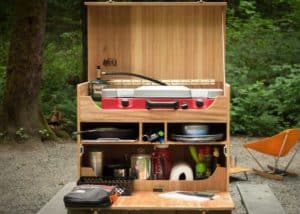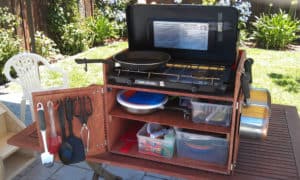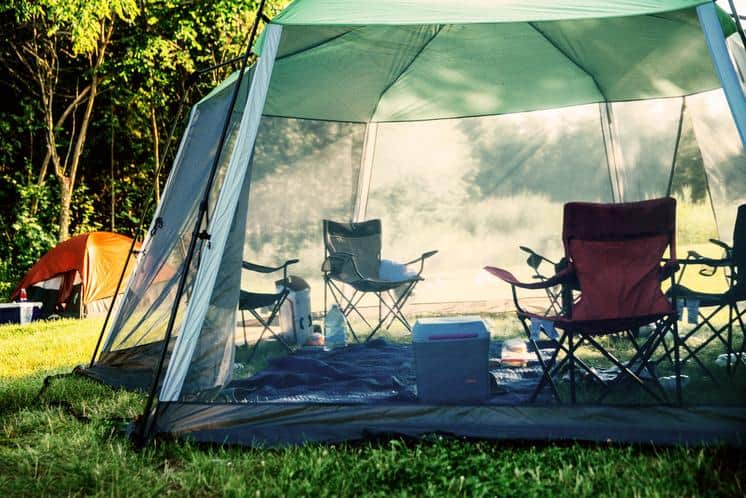For most of us, the camping trip starts days before the actual trip by searching and digging around the house to find all the necessary items for the campsite. What if there was a better way though? Let’s take a look at the camping box or camping kitchen box to see how it can make your camping life easier.
The camping box or camping kitchen box can help you get organized and stay organized before, during, and after the camping trip.
What is a Camping Box?
The camping box goes by many different names including camping kitchen box, camping chuck box, camping storage box, camping gear box, and a go box.
 The fact that so many names exist for this item is a testament to its versatility. The camping box can be many different things for many different people.
The fact that so many names exist for this item is a testament to its versatility. The camping box can be many different things for many different people.
However even though the camping storage box might go by many different names and can fulfill a variety of functions, the basic concept is a box that can store needed items for a camping trip.
What Can you Put In a Camping Box?
Anything and everything, that’s the great thing about the camping box or kitchen camping box.
With the camping chuck box you finally have a specific place to keep and store all of your camping items in one organized location. Whether it’s paper towels, bug spray, or extra batteries every item will have a specific place in the camping box.
This can be a great benefit for several reasons the first being that you don’t have to pack and unpack everything every time you head out or come back from a camping trip. The next benefit comes while you are at the campsite. As you will know exactly where everything is and where everything goes. So that you can spend less time searching and more time camping.
There is no doubt as your fellow camp-mates are digging in their trunk, or backseat looking for something. They will look on at your camping chuck box with envy, marveling at your organizational level while camping.
Types of Camping Boxes
The camping storage box can serve many different purposes and functions. However, typically camping boxes fall into two main categories including the general camping box or the camping kitchen box.
As you might have guessed the two different types of camping boxes can be differentiated by what contents are inside and the purpose they serve.
 While the general camping gear box might hold an assortment of items including flashlights, blankets, bug spray, and a tent. The camping kitchen box stores the necessary items for food prep and consumption at the campsite.
While the general camping gear box might hold an assortment of items including flashlights, blankets, bug spray, and a tent. The camping kitchen box stores the necessary items for food prep and consumption at the campsite.
Both of these camping boxes can be a great asset at the campsite to keep camp life easy and organized. In fact, it’s not uncommon for one campsite to have more than one camp box that serves different storage and useful purposes around the campsite.
Typical Materials
Camping boxes can be made from a variety of different materials including wood, rubber/ plastic, and metal.
The two most common materials used for camping storage boxes are wood and rubber/plastic due to their versatility and durability.
Both wood and rubber/plastic can be used to make a great camping box or kitchen camping box. Oftentimes wood camping boxes are specific built for certain applications by the camper and can be made to stand alone or even built inside a camper or vehicle.
On the other hand rubber/plastic camping boxes are more general in nature and typically bought from a company.
Both materials can be used to make a great camping box and your choice of material will depend on specific use and needs.
Designs and Uses
As with materials camping boxes can take many different forms and use several different designs depending on the application and specific use.
A camping box can be as simple as a large storage tote or as complex as a specific built camping box with multiple pull-outs, drawers, and shelves.
The most prevalent camping storage box seen at campsites though looks like a basic box where typically one side of the box will fold down creating a small workspace and the interior of the box will have various shelves and cubbies inside for storage. In addition sometimes camping boxes might have legs attached to the bottom as well allowing the box to be free-standing at working height.
Camping Box DIY or Store Bought
When considering the purchase of camping box or camping kitchen box which way should you go, DIY camping box or store-bought?
The answer to this question really depends on what you are looking to get from the camping box and your level of DIY skills.
Below is a list of pros and cons for each type of camping box to help you decide which might be the better choice for you.
DIY
Ensure good build quality.
Build cheaper than purchasing pre-built.
Requires tools and DIY skills.
Potential long build time.
Store Bought
No DIY skills needed.
Rubber/plastic material can be more durable than wood.
Not specific built for your needs.
If your DIY skills are lacking we like this camping box as well this camping box from Amazon.
Camping Box Checklist
So now that you know what a camping box and camping kitchen box is, what should you actually put in these handy organizers for your next camping trip?
Below is a list of items to help you get started filling up your camping box.
- Bug Spray
- Sunscreen
- Lighter or Matches
- Multi Tool / Hatchet
- Toilet Paper
- Flashlight
- Extra Batteries
- Tarp
- Rope
- Duct Tape
- Deck of Cards
- Binoculars
- Tent
- Sleeping Bags
- Sleeping Mats
- Blankets
Camping Kitchen Box Checklist
- Canister Stove and Fuel
- Paper Towels / Napkins
- Paper Plates
- Forks / Spoons / Knives
- Cups
- Roll of Aluminum Foil
- Zip Lock Bags
- Pot / Pan
- Tongs
- Cooking Knife
- Dish Soap
- Dish Towel
- Multiple Tupperware Containers

